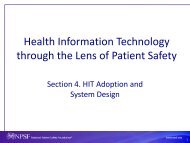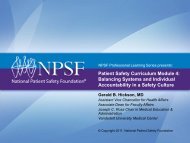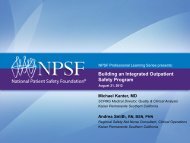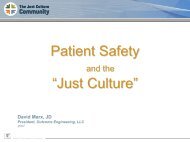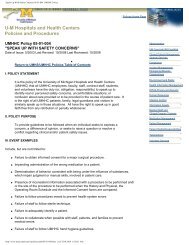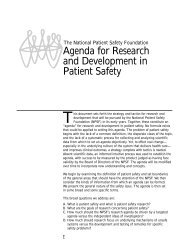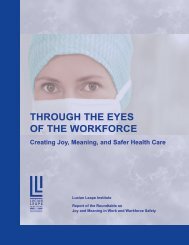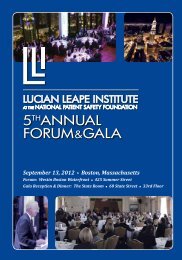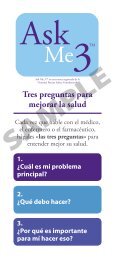Download the slides of this presentation - National Patient Safety ...
Download the slides of this presentation - National Patient Safety ...
Download the slides of this presentation - National Patient Safety ...
Create successful ePaper yourself
Turn your PDF publications into a flip-book with our unique Google optimized e-Paper software.
NPSF Pr<strong>of</strong>essional Learning Series presents:Applying Human Factors Engineeringand Systems <strong>Safety</strong> Approachesin Health CareRollin J. (Terry) Fairbanks, MD, MS, FACEPAttending Emergency Physician, MedStar Washington Hospital CenterAssociate Pr<strong>of</strong>essor <strong>of</strong> Emergency Medicine, Georgetown UniversityDirector, <strong>National</strong> Center for Human Factors Engineering in HealthcareMedStar Institute for Innovationwww.MedicalHumanFactors.netApril 25, 2012
Participant NotificationContinuing Education*:This educational activity <strong>of</strong>fers 1.0 contact hours.PharmacyInquisit ® is accredited by <strong>the</strong> Accreditation Council for Pharmacy Education as a provider <strong>of</strong>continuing pharmacy education. This program will provide 1.0 ACPE Contact Hours underprogram number 232-999-12-086-L04-P.NursingInquisit is accredited as a provider <strong>of</strong> continuing nursing education by <strong>the</strong> American NursesCredentialing Center’s COA.Inquisit is Iowa Board <strong>of</strong> Nursing provider 333 and 1.2 contact hours will be awarded for <strong>this</strong> program.*Continuing education credits are only available for live webcasts. A post-event survey must becompleted within 7 days <strong>of</strong> participation to receive continuing education credits.2NPSF Pr<strong>of</strong>essional Learning SeriesApril 25, 2012
DisclosureFaculty DisclosureRollin J. (Terry) Fairbanks, MD, MS, FACEP has disclosed no relevant, real orapparent personal or pr<strong>of</strong>essional financial relationships.Acknowledgement <strong>of</strong> Commercial SupportThere was no commercial support received for <strong>this</strong> CME activity.Questions?Contact Us at info@npsf.org or 617-391-99003NPSF Pr<strong>of</strong>essional Learning SeriesApril 25, 2012
Learning Objectives• Describe <strong>the</strong> systems approach to safety engineering• Describe how human factors engineering can impactsafety• Describe implications <strong>of</strong> system design, medical devicedesign, and health IT design in <strong>this</strong> context• Describe approaches to serious safety event reviewsthat will produce sustainable results• Describe how a just culture approach is important to <strong>the</strong>integration <strong>of</strong> a system safety engineering approach.4NPSF Pr<strong>of</strong>essional Learning SeriesApril 25, 2012
NPSF Pr<strong>of</strong>essional Learning Series presents:Human Factors Engineeringand Systems <strong>Safety</strong> Approachesin Health CareRollin J. (Terry) Fairbanks, MD, MS, FACEPAttending Emergency Physician, MedStar Washington Hospital CenterAssociate Pr<strong>of</strong>essor <strong>of</strong> Emergency Medicine, Georgetown UniversityDirector, <strong>National</strong> Center for Human Factors Engineering in HealthcareMedStar Institute for Innovationwww.MedicalHumanFactors.netApril 25, 2012
6NPSF Pr<strong>of</strong>essional Learning SeriesApril 25, 2012
The Problem• IOM Report in 2000:– Est. 44,000-98,000 deaths/year• Government mandate:50% less error in 5 years• 12 Years later….ESSENTAILLY NO CHANGE!!-----WHY?-----Leape LL, Berwick DM. Five years after To Err Is Human: what have we learned? JAMA. May 18 2005;293(19)Wachter RM. The end <strong>of</strong> <strong>the</strong> beginning: <strong>Patient</strong> <strong>Safety</strong> Five Years After 'To Err Is Human'. Health Aff. 2004(11)Wachter RM. <strong>Patient</strong> <strong>Safety</strong> At Ten: Unmistakable Progress, Troubling Gaps. Health Aff. 2010 (29:1)Landrigan, Parry, et al. Temporal Trends in Rates <strong>of</strong> <strong>Patient</strong> Harm Resulting from Medical Care. NEJM 363(22): 2010Shekelle, Pronovost, et al. Advancing <strong>the</strong> science <strong>of</strong> patient safety. Ann Int Med 154(10): 2011Longo, Hewett, Ge, Schubert. The long road to patient safety: a status report on patient safety systems. JAMA, 294(22): 2005.7NPSF Pr<strong>of</strong>essional Learning SeriesApril 25, 2012
Systems ApproachIs <strong>the</strong> goal to : “Eliminate Error?”NO• Human Error cannot be eliminated▫ Futile goal; misdirects resources/focus▫ Causes culture <strong>of</strong> blame and secrecy• “name, blame, shame, and train” mentality• It is about reducing HARM• retraining, policy, memos, M&M, etc do notcreate sustained improvement in safety8NPSF Pr<strong>of</strong>essional Learning SeriesApril 25, 2012
Chart Credit: Modified from L. Leape9NPSF Pr<strong>of</strong>essional Learning SeriesApril 25, 2012
Systems Approach• Pilots and ATC – make 2 errors per hour• Yet aviation: highly reliable, resilient, SAFE• Healthcare: 1 fatality per 10,000 admissionsOdds <strong>of</strong> being on an airline flight whichresults in at least one fatalityTop 25 airlines with <strong>the</strong> best accident rates1 in 5.4 millionOdds <strong>of</strong> being killed on a single airlineflightTop 25 airlines with <strong>the</strong> best accident rates1 in 9.2 millionfatal accidents fatalitiesDriving 1.32 1.47Airlines .05 1.57per 100 million milesSources: OAG Aviation & PlaneCrashInfo.com accident database, 1985 – 2009 ; Hayward &H<strong>of</strong>er, JAMA 200110NPSF Pr<strong>of</strong>essional Learning SeriesApril 25, 2012
Accident Causation Pyramid“Tip <strong>of</strong> <strong>the</strong> iceburg”• 1 serious or major injury• 10 minor injuries• 30 property damage injuries• 600 incidents with no visibledamage or injuryBird, 19691,753,498 accidents from 297 companies, 21 different industriesSlide acknowledgment: Robert Panzer, MD11NPSF Pr<strong>of</strong>essional Learning SeriesApril 25, 2012
Human Factors Engineering (HFE)• Human Factors Engineering:▫ Optimize relationship between technology and<strong>the</strong> human user: “Designing for human use”▫ Prominent in aviation, nuclear, military• Human Computer Interaction (Usability)▫ Ease <strong>of</strong> use and minimized use error• Cognitive Systems Engineering▫ Useful to support <strong>the</strong> work <strong>of</strong> <strong>the</strong> end user12NPSF Pr<strong>of</strong>essional Learning SeriesApril 25, 2012
13NPSF Pr<strong>of</strong>essional Learning SeriesApril 25, 2012
14NPSF Pr<strong>of</strong>essional Learning SeriesApril 25, 2012
Defibrillator Case• VF cardiac arrest• Nurse with patient• charges unit…• clears patient…• <strong>the</strong>n presses “on”button• Machine powers down• 2 minute delay in shock15NPSF Pr<strong>of</strong>essional Learning SeriesApril 25, 2012
Defibrillator Case• MEPARS.com: 3 EMS Reports• Simulation study (Denmark)▫ 72 physicians using common device▫ 5 <strong>of</strong> 192 defib attempts: device powered down• Mean delay: 24 seconds▫ Device can be turned <strong>of</strong>f even if charged &readyHoyer, Christensen, et al. (2008). "Adverse design<strong>of</strong> defibrillators: turning <strong>of</strong>f <strong>the</strong> machine whentrying to shock." Annals <strong>of</strong> Emergency Medicine52(5): 512-514.16NPSF Pr<strong>of</strong>essional Learning SeriesApril 25, 2012
Huh?17NPSF Pr<strong>of</strong>essional Learning SeriesApril 25, 2012
Defibrillator Case #2• 32 year old healthy man w/wife, young kids• Presents to ED with rapid heartbeat▫ Non-life threatening condition (SVT)• Synchronized shock @50j refractory• Try again @ 100j VF Arrest• 45m resuscitation attempt patient dies• Investigation reveals that MD failed to putdevice in SYNC mode for second shock18NPSF Pr<strong>of</strong>essional Learning SeriesApril 25, 2012
Defibrillator Usability Study• Fourteen expert participants• Four tasks: 2 routine, 2 emergent• Two defibrillator models• SimMan TM patient simulator• 50% <strong>of</strong> participants inadvertentlydelivered an unsynchronizedcountershock for SVT▫ 71% <strong>of</strong> participants never aware‣Fairbanks RJ, Caplan SH, et al. Usability Study <strong>of</strong> Two Common Defibrillators Reveals Hazards.Annals <strong>of</strong> Emergency Medicine Oct 2007; 50(4): 424-432.[See also associated editorial: Karsh and Scanlon, Oct 2007; 50(4): 433-435]19NPSF Pr<strong>of</strong>essional Learning SeriesApril 25, 2012
Response“Physician should have taken time to askED staff for an operator’s manual for <strong>the</strong>defibrillator and read it after he arrived in<strong>the</strong> ED to perform a cardioversion”“<strong>the</strong> preventative or corrective action isprovided in <strong>the</strong> device labeling”Fairbanks RJ and Wears RL. Hazards With Medical Devices: <strong>the</strong> Role<strong>of</strong> Design.Annals <strong>of</strong> Emergency Medicine Nov 2008; 52(5): 519-521.20NPSF Pr<strong>of</strong>essional Learning SeriesApril 25, 2012
Labelsdon’t workPhoto Credit: Neighborhood Watch (Fox, 2012 movie)21NPSF Pr<strong>of</strong>essional Learning SeriesApril 25, 2012
22NPSF Pr<strong>of</strong>essional Learning SeriesApril 25, 2012
23NPSF Pr<strong>of</strong>essional Learning SeriesApril 25, 2012
24NPSF Pr<strong>of</strong>essional Learning SeriesApril 25, 2012
25NPSF Pr<strong>of</strong>essional Learning SeriesApril 25, 2012
Cognitive systems engineering:Example: Transition to Health IT26NPSF Pr<strong>of</strong>essional Learning SeriesApril 25, 2012
27NPSF Pr<strong>of</strong>essional Learning SeriesApril 25, 2012
28NPSF Pr<strong>of</strong>essional Learning SeriesApril 25, 2012
29NPSF Pr<strong>of</strong>essional Learning SeriesApril 25, 2012
today5 months ago5 months ago30NPSF Pr<strong>of</strong>essional Learning SeriesApril 25, 2012
Who knows?31NPSF Pr<strong>of</strong>essional Learning SeriesApril 25, 2012
32NPSF Pr<strong>of</strong>essional Learning SeriesApril 25, 2012
Prescription Writing Task1133NPSF Pr<strong>of</strong>essional Learning SeriesApril 25, 2012
34NPSF Pr<strong>of</strong>essional Learning SeriesApril 25, 2012
Anatomically orientedIs <strong>this</strong> <strong>the</strong> best way?<strong>National</strong> Center for Human Factors Engineering in Healthcarewww.MedicalHumanFactors.
Example…Multiple inpatientPEs occur over 2yearsAudit: 50%Compliance withHospital VTEguideline…WHY are those doctorsso non-compliant?36NPSF Pr<strong>of</strong>essional Learning SeriesApril 25, 2012
37NPSF Pr<strong>of</strong>essional Learning SeriesApril 25, 2012
38NPSF Pr<strong>of</strong>essional Learning SeriesApril 25, 2012
39NPSF Pr<strong>of</strong>essional Learning SeriesApril 25, 2012
Result <strong>of</strong> CPOE Pathway• Readily accepted by physicians• Increase in appropriate prophylaxis rates50% 66% 93%Fairbanks RJ, Caplan S, Panzer RJ. Integrating Usability Into Development Of A ClinicalDecision Support System. Proceedings <strong>of</strong> HCI-International 2005, Mira DigitalPublishing (ISBN 0-8058-5807-5). July 2005; Las Vegas, Nevada.40NPSF Pr<strong>of</strong>essional Learning SeriesApril 25, 2012
23 minutes…41NPSF Pr<strong>of</strong>essional Learning SeriesApril 25, 2012
42NPSF Pr<strong>of</strong>essional Learning SeriesApril 25, 2012
Fatal Arrhythmia:<strong>Patient</strong> is dyingArtifact:<strong>Patient</strong> is moving43NPSF Pr<strong>of</strong>essional Learning SeriesApril 25, 2012
Alarms• Placement <strong>of</strong>monitorsNurses sitalong here44NPSF Pr<strong>of</strong>essional Learning SeriesApril 25, 2012
Alarm Fatigue• There is no clinically significant interactionbetween ibupr<strong>of</strong>en and famotidine45NPSF Pr<strong>of</strong>essional Learning SeriesApril 25, 2012
Too s<strong>of</strong>t, you say?46NPSF Pr<strong>of</strong>essional Learning SeriesApril 25, 2012
Just Culture:The Three BehaviorsNormalErrorAt-RiskBehaviorRecklessBehaviorInadvertent action: slip, lapse,mistakeA choice: risk not recognizedor believed justifiedConscious disregard <strong>of</strong>unreasonable riskManage through changes in:Manage through:Manage through:• Processes• Procedures• Recurrent training• Design• Environment• Removing incentives for At-Risk Behaviors• Creating incentives forhealthy behaviors• Increasing situationalawareness• Re-examining environment• Remedial action• Punitive actionSupport Coach SanctionAdapted from: David Marx, Just Culture. Outcome Engineering 2008: www.JustCulture.orgSee also, Just Culture: Balancing <strong>Safety</strong> and Accountability, Sidney Dekker (2008)47NPSF Pr<strong>of</strong>essional Learning SeriesApril 25, 2012
Reducing Risk:Where should we focus?• Focus on Hazards▫ Near misses▫ Dangerous conditions, situations, etc▫ Recognize and report hazards▫ Develop <strong>the</strong> culture by recognizing system contributions• Then you’ll learn more about hazards in your system▫ RCAs• Recognize <strong>the</strong> system contributions• Examine with <strong>the</strong> lens <strong>of</strong> human factors▫ Ask staff about “accidents waiting to happen”48NPSF Pr<strong>of</strong>essional Learning SeriesApril 25, 2012
Reducing Risk:Where should we focus?• Focus on contributing factors that can bechanged▫ System factor focus in RCAs & incident reviews▫ System and device/IT design to support worker▫ Study near misses▫ Non-punitive QA systems/Just Culture▫ Culture change-facilitated by leadership▫ Red Rules? Leadership’s responsibility49NPSF Pr<strong>of</strong>essional Learning SeriesApril 25, 2012
What DOES NOT reduce risk• Changes after an adverse event/RCA:▫ “Failure to follow policy” (or procedure) asprimary root cause▫ “Develop policy” or “train staff” or “counsel” asprimary action▫ “Human Error” as a cause without contributingfactors▫ Any flavor <strong>of</strong> <strong>the</strong> “name, blame, and train”approach50NPSF Pr<strong>of</strong>essional Learning SeriesApril 25, 2012
Putting it to work• Facilitate culture change• Open lines <strong>of</strong> communication (reporting)• Employ system safety analysis techniques• Enact protective system changes (slices)• No “name, blame, shame, & train”• “I could have told you that was going tohappen…”51NPSF Pr<strong>of</strong>essional Learning SeriesApril 25, 2012
Final Thoughts…• 12 years later….Why No Change?– Focus is STILL on <strong>the</strong> individual– Focus is on local level– Team dynamics– Communication– Hierarchical Culture– Culture <strong>of</strong> Blame52NPSF Pr<strong>of</strong>essional Learning SeriesApril 25, 2012
Final Thoughts…• Fallibility is part <strong>of</strong> <strong>the</strong> human condition• We cannot change <strong>the</strong> human condition• We can change <strong>the</strong> conditions under whichpeople work--Jim Reason53NPSF Pr<strong>of</strong>essional Learning SeriesApril 25, 2012
Easy Reads** & Reference**Set Phasers on Stun, Steve Casey (1998)**The Design <strong>of</strong> Everyday Things, D. Norman (1988)**The Field Guide to Understanding Human Error (2006) SidneyDekker** Just Culture: Balancing <strong>Safety</strong> and Accountability, SidneyDekker (2008)Handbook <strong>of</strong> Human Factors and Ergonomics in Health Care and<strong>Patient</strong> <strong>Safety</strong>, 2 nd ED; P. Carayon (2012)<strong>Patient</strong> <strong>Safety</strong> in Emergency Medicine. Croskerry, Cosby,Schenkel, and Wears (2009)Human Error, James Reason (1990)Normal Accidents, Charles Perrow (1984)54NPSF Pr<strong>of</strong>essional Learning SeriesApril 25, 2012
Rollin J. (Terry) Fairbanks, MD, MS, FACEPDirector<strong>National</strong> Center for Human Factors Engineering in HealthcareMedStar Institute for InnovationAssociate Pr<strong>of</strong>essor <strong>of</strong> Emergency MedicineGeorgetown University School <strong>of</strong> MedicineAdjunct Associate Pr<strong>of</strong>essor <strong>of</strong> Industrial Systems EngineeringUniversity at Buffalo School <strong>of</strong> EngineeringEmergency Medicine Attending PhysicianMedStar Washington Hospital Centerwww.MedicalHumanFactors.netTerry.Fairbanks@MedicalHFE.org55NPSF Pr<strong>of</strong>essional Learning SeriesApril 25, 2012
Submit A Question56NPSF Pr<strong>of</strong>essional Learning SeriesApril 25, 2012
CE Certificate Instructions*Please direct your browser to www.inquisit.org/surveyPlease enter NPSFWebcast (uppercase NPSFW) Click <strong>the</strong> Submit button.Account Creation: Click <strong>the</strong> first hyperlink entitled create account and follow <strong>the</strong> registrationscreens.If you believe you have an Inquisit account click find accountIf you forgot your password, please click <strong>the</strong> forgot password hyperlink.Please enter <strong>the</strong> exact way you would like your name displayed on <strong>the</strong> certificate.Please check <strong>the</strong> CE accreditation you wish to earn and <strong>the</strong>n click <strong>the</strong> Submit buttonYour Webinar title is listed. Click <strong>the</strong> title.Please provide your input on <strong>the</strong> very brief evaluation survey and click <strong>the</strong> submit button.This will trigger <strong>the</strong> system to build your certificate. You will receive a link on <strong>the</strong> screen infront <strong>of</strong> you to review and print your certificate AND an auto e-mail is sent to your e-mailaddress with <strong>the</strong> same link.*Continuing education credits are only available for live webcasts. A post-event survey must be completed within 7 days <strong>of</strong>participation to receive continuing education credits.57NPSF Pr<strong>of</strong>essional Learning SeriesApril 25, 2012




